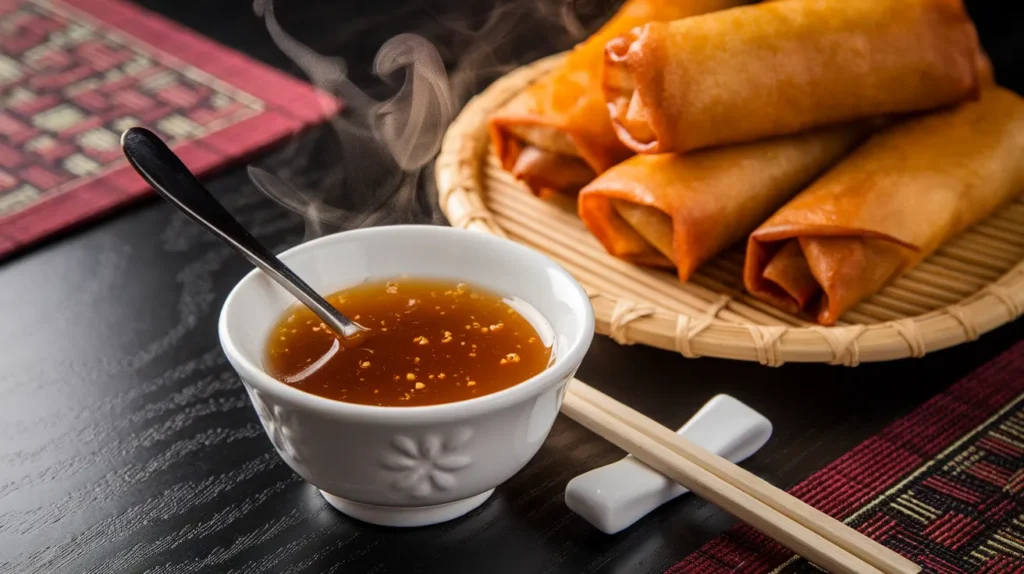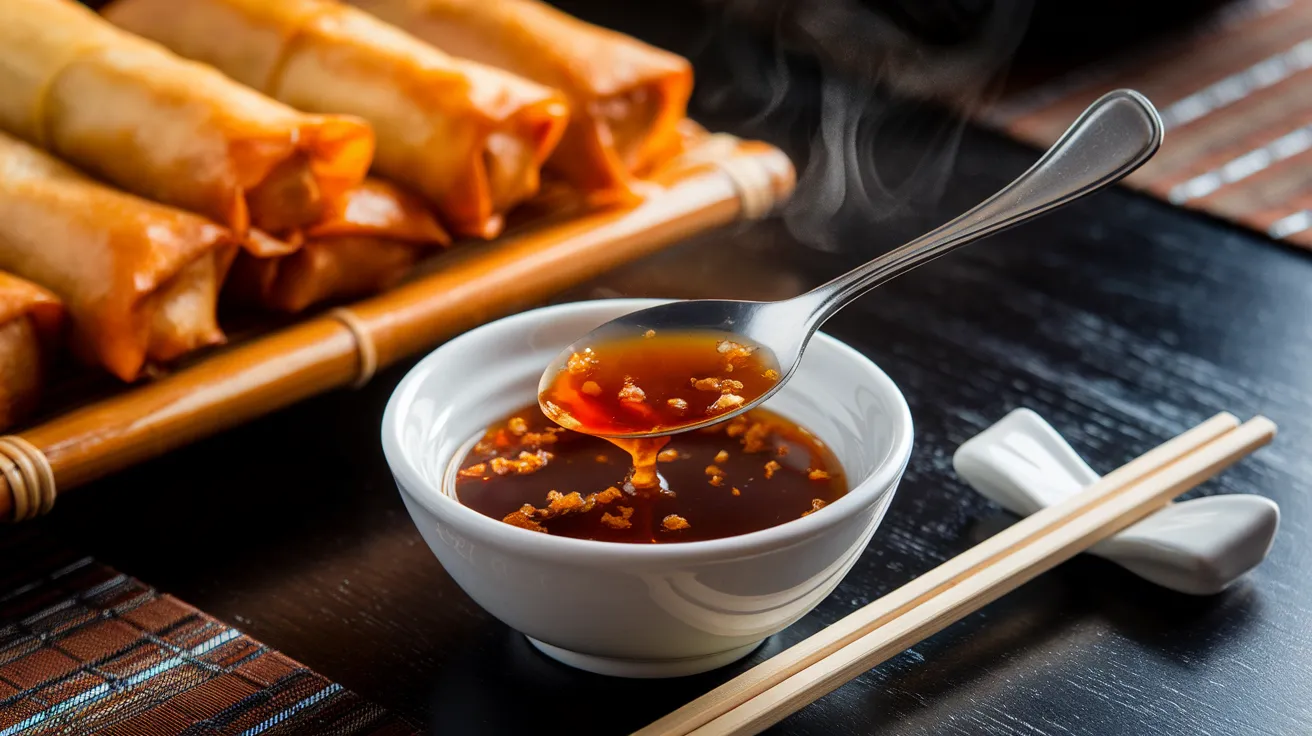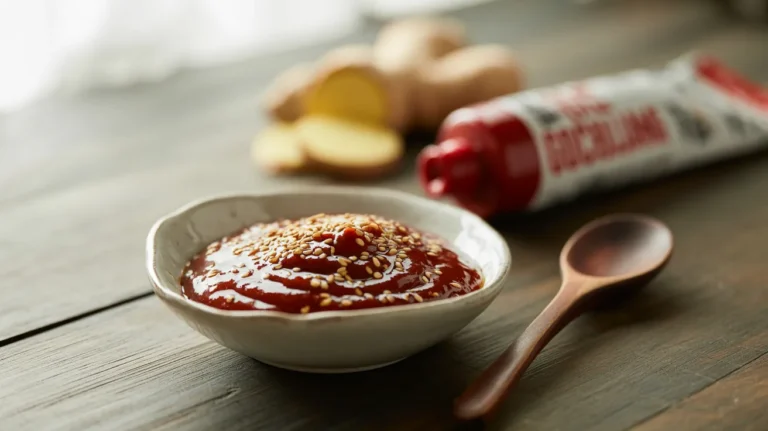This homemade sauce for egg rolls creates the perfect sweet and tangy complement to your crispy appetizers. Our authentic sauce for egg rolls recipe combines traditional Asian flavors with simple techniques, ensuring even beginners can master this essential dipping sauce that rivals your favorite restaurant’s version.
Recipe Info Bar
SERVES: 4 | PREP: 10 MIN | COOK: 8 MIN | TOTAL: 18 MIN
Ingredients
Base Sauce for Egg Rolls Components
| Ingredient | Amount | Notes |
|---|---|---|
| Soy sauce | 1/4 cup | Low-sodium preferred |
| Rice vinegar | 3 tablespoons | White vinegar works too |
| Brown sugar | 2 tablespoons | Packed measurement |
| Honey | 1 tablespoon | Pure honey recommended |
| Water | 1/4 cup | Room temperature |
Flavor Enhancers
| Ingredient | Amount | Notes |
|---|---|---|
| Fresh ginger | 1 teaspoon | Finely minced |
| Garlic | 2 cloves | Minced fresh |
| Sesame oil | 1/2 teaspoon | Toasted variety |
| Red pepper flakes | 1/4 teaspoon | Optional for heat |
Thickening Agent
| Ingredient | Amount | Notes |
|---|---|---|
| Cornstarch | 1 tablespoon | Mixed with water |
| Cold water | 2 tablespoons | For slurry |
Detailed Step-by-Step Instructions for Perfect Sauce for Egg Rolls
Phase 1: Complete Preparation Setup (5-6 minutes)
Step 1: Organize Your Workspace Start by clearing your counter space and gathering all ingredients in one area. Place your small saucepan on the stove (don’t turn on heat yet) and have a whisk, measuring spoons, and small mixing bowls within arm’s reach. This preparation prevents rushing once you start cooking your sauce for egg rolls.
Step 2: Create the Perfect Cornstarch Slurry In a small bowl, measure 1 tablespoon cornstarch exactly – level off the spoon with a knife for accuracy. Add 2 tablespoons cold water and whisk vigorously for 30 seconds until completely smooth. The mixture should look like thin milk with no lumps visible. Set this aside – you’ll use it later to thicken your sauce. Why this matters: Cold water prevents the cornstarch from clumping when mixed with hot liquid.
Step 3: Prepare Fresh Aromatics Properly Take 2 fresh garlic cloves and remove the papery skin completely. Using a sharp knife, slice each clove thinly, then rock your knife over the slices to create tiny, uniform pieces about 1/8-inch in size. For the ginger, use a spoon to scrape off the skin, then mince 1 teaspoon into pieces the same size as your garlic. Beginner tip: Mincing aromatics finely ensures they distribute evenly and don’t create large chunks in your finished sauce.
Step 4: Pre-measure All Liquid Ingredients Measure 1/4 cup soy sauce into one small bowl, 3 tablespoons rice vinegar into another, and 1/4 cup room temperature water into a third. Having these pre-measured prevents scrambling while cooking. Safety note: Never leave the stove unattended to measure ingredients once cooking begins.
Phase 2: Building Your Sauce for Egg Rolls Base (3-4 minutes)
Step 5: Heat Management for Beginners Turn your burner to medium heat and let the empty saucepan warm for exactly 30 seconds. You’ll know it’s ready when you hold your hand 4 inches above the pan and feel gentle warmth. Temperature check: The pan should be warm but not smoking – if you see any smoke, turn the heat down immediately.
Step 6: Aromatics Technique Add your minced garlic and ginger directly to the warm, dry pan. Using your whisk, stir constantly for 30-45 seconds. You’ll hear gentle sizzling and smell the aromatics becoming fragrant – this is exactly what you want. The garlic should turn slightly golden but never brown. Visual cue: If the aromatics start browning quickly, lower your heat immediately.
Step 7: Adding Liquids Without Splashing Remove the pan from heat temporarily for safety. Pour in your pre-measured soy sauce first, followed by rice vinegar, then water. The liquid will bubble slightly when it hits the warm pan – this is normal. Return the pan to medium heat and whisk everything together until completely combined. Why this sequence matters: Adding liquids off heat prevents dangerous splashing.
Phase 3: Sweetening and Flavor Development (2-3 minutes)
Step 8: Sugar Dissolution Technique Add 2 tablespoons brown sugar directly to your liquid mixture. Using your whisk, stir in a figure-8 pattern for 45 seconds until you can no longer see any sugar granules. The mixture will look slightly cloudy at first, then clear as the sugar dissolves completely. Test for doneness: Dip your spoon in – if you feel any grittiness, keep stirring.
Step 9: Honey Integration Method Drizzle 1 tablespoon honey slowly into the center of your pan while whisking continuously. The honey will initially sink to the bottom, but constant whisking will incorporate it smoothly. Continue whisking for 30 seconds until the mixture looks glossy and uniform in color. Beginner mistake to avoid: Don’t add honey to a pan that’s too hot, as it can burn quickly.
Step 10: Final Seasoning Additions Remove the pan from heat briefly and add 1/2 teaspoon sesame oil and 1/4 teaspoon red pepper flakes (if using). Whisk these in completely – the sesame oil will make your sauce for egg rolls smell authentically Asian, while the pepper flakes add gentle heat. Return to medium heat immediately.
Phase 4: Thickening Your Sauce for Egg Rolls (3-4 minutes)
Step 11: Achieving the Perfect Simmer Watch your sauce carefully as it heats. You’ll see small bubbles forming around the edges first – this means you’re almost at a simmer. When bubbles appear consistently around the entire perimeter and a few in the center, you’ve reached the perfect gentle simmer. Temperature indicator: The surface should look active but not violently bubbling.
Step 12: Cornstarch Slurry Addition Technique Give your prepared cornstarch slurry one final whisk to ensure it’s smooth. While whisking your simmering sauce continuously, pour the slurry in a thin, steady stream – never dump it all at once. Continue whisking vigorously for 15 seconds to prevent any lumps from forming. Critical timing: Add the slurry within 30 seconds of reaching a simmer for best results.
Step 13: Achieving Perfect Consistency Continue cooking while whisking constantly for 1-2 minutes. Your sauce will gradually thicken and become glossy. To test consistency, dip a clean spoon in the sauce and hold it up – the perfect sauce for egg rolls should coat the spoon and drip off slowly, not run off like water. Visual check: The sauce should be thick enough to cling to your egg rolls but thin enough to dip easily.
Step 14: Final Taste and Adjustment Remove from heat and taste your sauce carefully (it will be hot!). The flavor should balance sweet, salty, and tangy notes perfectly. If too salty, add 1/2 teaspoon honey. If too sweet, add 1/2 teaspoon rice vinegar. If too thin, return to heat and simmer 30 seconds more. Perfect balance indicator: You should taste all three flavor components without any single one overpowering the others.
Step 15: Proper Cooling and Serving Transfer your finished sauce for egg rolls to a serving bowl and let it cool for 2-3 minutes before serving. The sauce will continue to thicken slightly as it cools to the ideal dipping consistency. Serving temperature tip: Room temperature sauce allows the best flavor balance and won’t make your crispy egg rolls soggy.
Chef’s Notes for Perfect Sauce for Egg Rolls
• Heat control is everything: Medium heat prevents burning while allowing proper flavor development. Your sauce for egg rolls should never boil violently.
• Timing the thickener: Add cornstarch slurry only when the sauce reaches a gentle simmer. Too early and it won’t activate; too late and you risk lumps.
• Make-ahead advantage: This sauce for egg rolls tastes even better after 30 minutes, allowing flavors to meld completely.
• Consistency secrets: If your sauce becomes too thick while cooling, whisk in warm water one teaspoon at a time until perfect.
Nutrition Box (Per Serving)
- Calories: 45
- Protein: 1g
- Carbohydrates: 11g
- Fat: 0.5g
- Sodium: 580mg
- Sugar: 9g
Creative Sauce for Egg Rolls Variations
Spicy Asian Fusion
Transform your basic sauce for egg rolls by whisking in 1 tablespoon sriracha sauce during Phase 3. This creates the perfect balance of sweet, sour, and spicy heat that complements both vegetable and meat-filled egg rolls beautifully.
Tropical Pineapple Twist
Include 2 tablespoons pineapple juice and 1 tablespoon finely minced fresh pineapple for a sweet tropical variation. This version pairs exceptionally well with shrimp or vegetable egg rolls.
Extra Ginger Sauce for Egg Rolls
Double the fresh ginger to 2 teaspoons and add 1/4 teaspoon ground ginger for an extra warming kick. Perfect for cold weather entertaining when you want bold, warming flavors.
Restaurant-Style Thick Version
Increase cornstarch to 2 tablespoons mixed with 3 tablespoons water for a thicker consistency that clings perfectly to egg rolls. This variation also works wonderfully as sauce for empanadas dipping.
Storage & Reheating Your Sauce for Egg Rolls
Refrigerator Storage: Store your cooled sauce for egg rolls in an airtight container for up to 7 days. The flavors actually develop and improve over the first 24 hours.
Freezing Instructions: This sauce freezes beautifully for up to 3 months. Pour into ice cube trays for individual serving portions that thaw quickly.
Reheating Methods:
- Microwave: Heat in 15-second intervals, stirring between each until warm
- Stovetop: Warm gently over low heat, adding water if needed to thin
- Room Temperature: Allow frozen sauce to thaw completely, then stir before serving
Consistency Recovery: If your reheated sauce for egg rolls seems too thick, whisk in 1-2 teaspoons warm water gradually until you reach the perfect dipping consistency.

Troubleshooting Common Sauce for Egg Rolls Problems
Problem: Sauce is too salty
Solution: Add 1 teaspoon honey and 1 tablespoon rice vinegar to balance the saltiness. Whisk thoroughly and taste again. Repeat if necessary until balanced.
Problem: Sauce won’t thicken properly
Solution: Mix 1 teaspoon cornstarch with 2 teaspoons cold water until smooth. Whisk into gently simmering sauce and cook for 1 additional minute while stirring constantly.
Problem: Lumpy texture in finished sauce
Solution: Strain the entire sauce through a fine-mesh sieve, pressing lumps with the back of a spoon. Return strained sauce to pan and reheat gently while whisking.
Problem: Sauce for egg rolls is too sweet
Solution: Add 1 tablespoon rice vinegar and 1/4 teaspoon soy sauce to balance the sweetness without starting over completely.
Problem: Sauce separates after cooling
Solution: Whisk vigorously while gently reheating, or use an immersion blender for 10 seconds to re-emulsify all ingredients smoothly.
Essential Equipment for Making Sauce for Egg Rolls
• Small heavy-bottomed saucepan (prevents hot spots that can burn your sauce) • Wire whisk (ensures smooth consistency throughout cooking) • Fine-mesh strainer (optional, for ultra-smooth professional texture) • Small mixing bowls (for preparing ingredients and cornstarch slurry) • Accurate measuring cups and spoons (precision creates consistent results) • Heat-resistant rubber spatula (for scraping down pan sides)
Complete Shopping List for Sauce for Egg Rolls
Pantry Section
- Low-sodium soy sauce
- Rice vinegar (or white vinegar substitute)
- Brown sugar
- Pure honey
- Cornstarch
- Toasted sesame oil
- Red pepper flakes (optional)
Fresh Produce Section
- Fresh ginger root (buy extra – it keeps well frozen)
- Fresh garlic bulbs
Asian Condiment Aisle
- Toasted sesame oil (if not found in pantry section)
- Alternative vinegars if rice vinegar unavailable
This versatile sauce for egg rolls recipe also works wonderfully as a sauce for edamame when you want to add authentic Asian flavors to your appetizer spread.
Five Success Secrets for Perfect Sauce for Egg Rolls
- Master your mise en place – prepare and measure every ingredient before you start cooking. Once your sauce for egg rolls begins simmering, you won’t have time to stop and measure.
- Temperature control wins every time – keep heat at medium or lower throughout the entire process. High heat will cause sugars to burn, creating irreversible bitter flavors.
- Taste before thickening – once you add cornstarch, the flavors become much harder to adjust effectively. Perfect your seasoning first, then thicken.
- Double your batch – this sauce for egg rolls keeps excellently and having extra on hand makes weeknight appetizers completely effortless.
- Serve at optimal temperature – room temperature sauce allows all the sweet, sour, and savory notes to shine perfectly, while preventing your crispy egg rolls from becoming soggy.
Master this authentic sauce for egg rolls recipe and you’ll never need takeout dipping sauce again. The perfect balance of traditional Asian flavors makes this the ideal accompaniment for homemade or store-bought egg rolls, elevating any appetizer spread to restaurant quality.




